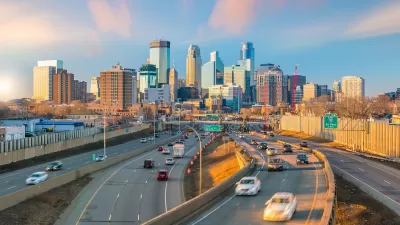If even a small fraction of workers continue to work remotely or have more flexible hours, the resulting reduction in rush hour travelers could have a significant impact on peak hour congestion.

With a third of U.S. workers in jobs that can be performed remotely, the traditional rush hour–that "uniquely awful" time of day when red brake lights know no end and "there is no good way to get around"–could be history. During the pandemic, writes Emily Badger in the New York Times, people not only worked remotely but also adjusted their work schedules to more flexible hours, flattening traffic peaks and reducing congestion. But, even as the economy reawakens and traffic starts to return, "planners, transit agencies and researchers are now considering the remarkable possibility that in many places it won’t revert to its old shape amid newfound work flexibility."
According to Badger, even a small shift in work hours could make a major difference. Because "roadway congestion is nonlinear," even "a modest number of people working from home on a Thursday" could make peak hour commutes "perceptibly less miserable." This goes for passenger comfort on public transit, too. "Until all the seats are gone, more passengers don’t affect you much. But once the aisle starts to fill up, every new body erodes your personal space and compounds chaos at the boarding door." Research has shown that "marginal changes in commute behavior on Jewish holidays, when most employers remain open but a small share of commuters stays home," create visible benefits in rush hour traffic reduction. "In Washington, D.C., compressed schedules and telework policies for federal workers had created noticeably saner traffic on Friday mornings. On the region’s Metrorail, peak ridership before the pandemic was consistently 10 percent to 15 percent lower on Fridays than midweek."
For decades, the "central paradigm of transportation planning" revolved around how to make rush hour less terrible. If we are able to ease demand at peak times, we can "consider a universe where more people don’t have to time their lives to the rhythm of rush hour — and where whole cities aren’t so preoccupied by what to do about it."
FULL STORY: A Little More Remote Work Could Change Rush Hour a Lot

Maui's Vacation Rental Debate Turns Ugly
Verbal attacks, misinformation campaigns and fistfights plague a high-stakes debate to convert thousands of vacation rentals into long-term housing.

Planetizen Federal Action Tracker
A weekly monitor of how Trump’s orders and actions are impacting planners and planning in America.

San Francisco Suspends Traffic Calming Amidst Record Deaths
Citing “a challenging fiscal landscape,” the city will cease the program on the heels of 42 traffic deaths, including 24 pedestrians.

Adaptive Reuse Will Create Housing in a Suburban Texas Strip Mall
A developer is reimagining a strip mall property as a mixed-use complex with housing and retail.

Study: Anti-Homelessness Laws Don’t Work
Research shows that punitive measures that criminalized unhoused people don’t help reduce homelessness.

In U.S., Urban Gondolas Face Uphill Battle
Cities in Latin America and Europe have embraced aerial transitways — AKA gondolas — as sustainable, convenient urban transport, especially in tricky geographies. American cities have yet to catch up.
Urban Design for Planners 1: Software Tools
This six-course series explores essential urban design concepts using open source software and equips planners with the tools they need to participate fully in the urban design process.
Planning for Universal Design
Learn the tools for implementing Universal Design in planning regulations.
Heyer Gruel & Associates PA
JM Goldson LLC
Custer County Colorado
City of Camden Redevelopment Agency
City of Astoria
Transportation Research & Education Center (TREC) at Portland State University
Jefferson Parish Government
Camden Redevelopment Agency
City of Claremont





























